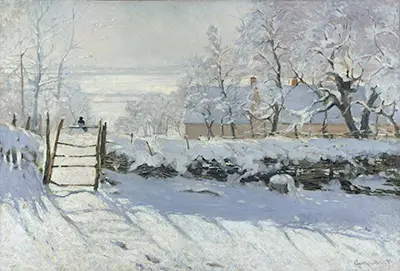Monet painted this snowy scene in the Winter of 1868 - 1869 close to his home at the time, near Etretat, Normandy. He had gone to live there with his girlfriend and new-born son.
While there the local artist Eugene Boudin influenced the painter to begin painting on-site, outside and The Magpie became one of approximately 140 winter paintings that Monet created "en plein air" (the French term for painting in the open air).
This painting represented a move away from the earlier style of the late 18th to early 19th century. Previously others had concentrated on precision, detail and structure. Prior to The Magpie academic artisans had favoured using black to illustrate shadow.
The most striking feature of The Magpie is the use of colour. In this painting Monet chose to highlight the multiple shades that he observed in the snowscape and so the shadows are cast in pale blue and yellow tones.
This new technique of adding colour can be compared and contrasted with an earlier example of Monet's painting A Cart on the Snowy Road at Honfleur. This work was Monet's first snowscape and he used the more traditional methods of utilising a black and grey palette to depict the wintery scene.
The use of colour to illustrate shadows became a defining characteristic of the Impressionist movement. Monet managed to capture the evanescence of the light. There is a luminous quality to the whole painting. The reds, yellows and blues in the sky bring a warmth to the scene. The whole effect is of a realistic, almost photographic, illustration.
However, on closer inspection Monet has used short, rapid brushstrokes and finer details are eluded to, rather than precisely copied. This sort of style gave Impressionism it's name.
Monet captures the atmosphere beautifully in The Magpie. The painting exudes qualities of stillness and silence yet conveys the passage of time concurrently. The solitary bird perched on the gate provides a focal point to the snowy landscape. Its presence is the only existence of a true jet black shade in the entire piece. The lone magpie also serves the purpose of accentuating the transient nature of life itself.
The shadow of the magpie is not a true reflection of how it's silhouette should have been represented. This may further signify the momentariness of nature. It may have served to highlight the Impressionist intent of capturing a snapshot of moving time rather than the still-life static of the previous photographic style of art.
This artwork, The Magpie, was a pioneering piece of art at it's time and this invited a lot of criticism. It was rebuffed by The Salon for the official art exhibition in Paris in 1869.
However, winter scenes became extremely prevalent among Impressionists with similar art being created by other artists such as Sisley and Pissarro. The Magpie has now become one of Monet's most popular pieces and modern day critics have claimed it is one of Monet's best snowscapes. The original artwork can be found in the Musee d'Orsay, Left Bank, Paris.


